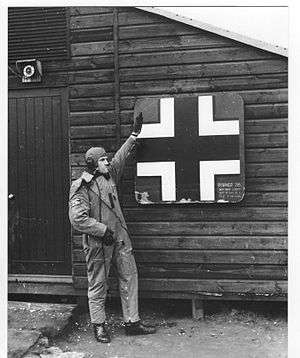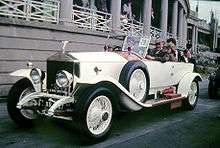Barrie Heath
| Barrie Heath | |
|---|---|
|
Barrie Heath photographed on the wing of Spitfire IIa P7883 "Grahaeme Heath", which had been donated by his parents in memory of his older brother, a pilot in the Royal Flying Corps who was killed in World War I | |
| Birth name | Barrie Heath |
| Born |
11 September 1916 Kings Norton, Warwickshire |
| Died |
22 February 1988 (aged 71)[1] Buckinghamshire, England |
| Allegiance |
|
| Service/branch |
|
| Years of service | 1938–1946 |
| Rank | Wing Commander |
| Unit |
No. 611 Squadron RAF No. 43 Squadron RAF No. 324 Wing Commander |
| Battles/wars | |
| Awards | Distinguished Flying Cross |
| Relations |
Grahame Heath (Older Brother) Duncan Heath (Son) |
| Other work |
Triplex Safety Glass Ltd Employee (1960) Pilkington Brothers Director (1967) Chairman of GKN (1975) |


Sir Barrie Heath, DFC, AE (11 September 1916 – 22 February 1988) was a World War II Royal Air Force Spitfire pilot who fought in the Battle of Britain, and was awarded the Distinguished Flying Cross. After the war he had a successful career in industry, rising to become chairman of the industrial conglomerate GKN. In 1978 he received a knighthood for services to export.
Early life
Heath was born in Kings Norton, Warwickshire on 11 September 1916. His older brother Grahame was a pilot in the Royal Flying Corps and was killed in action in World War I.
Battle of Britain
Heath saw active service in 1940 with No. 611 Squadron RAF, flying in Spitfire IIa P7883 "Grahame Heath", which had been donated by his parents in memory of his brother.[2]
Such donations were not uncommon at the time; many patriotic individuals as well as towns and other organisations were encouraged to donate the cost of an airframe. The cost of a Spitfire was set by the government at £5,000, a very large sum at the time, although the real cost of manufacturing the aircraft was more than £10,000. By way of honouring the donation, the aircraft was permitted to bear the name of the donor himself, or any other name they chose. Approximately 1500 "presentation" Spitfires were donated during the course of the war, representing about 17% of total production.[3][4]
Criticised by squadron CO S/L James Ellis McComb for damaging his Spitfire on landing, Heath is said to have replied: "this is my Spit and I'll fly it any bloody way I like".[5]
According to the official No. 611 Squadron RAF website, between June 1940 and February 1941 Heath shot down 4 enemy aircraft (including two "probables") and damaged two others.[6] He was made 'B' Flight Commander in November 1940.
Early in 1941 he was posted to No. 64 Squadron, becoming CO in March 1941. He was rested in September 1941, transferring to Fighter Command HQ, and in late 1942 was Wing Commander, Tactics. In 1944 he became Wing Leader, 244 Wing in Italy, later commanding 324 Wing.
| Dates | Aircraft | Result |
|---|---|---|
| 2 June 1940 | Junkers Ju87 | Destroyed |
| 21 August 1940 | Dornier Do17 | Probable |
| 11 October 1940 | Dornier Do17 | Probable |
| 21 December 1940 | Dornier Do17 | Damaged |
| 29 December 1940 | Dornier Do17 | Damaged |
| 5 February 1941 | Messerschmitt Bf 109 | Destroyed |
[7] In 1944, as the tide of war turned in favour of the Allies, Heath (by now Wing Commander Heath) served with No. 43 Squadron RAF in France, known by its squadron insignia as the "fighting cocks", or "les coqs Anglais" as the local French population dubbed it. By now the squadron's main role was ground attack, strafing and occasionally dive bombing enemy targets.
On 9 September 1944 Heath, now No. 324 Wing Commander and flying Spitfire IX MJ628, led a formation on the squadron's first sortie into German territory, strafing motor transport and railway communications.[8]
Post war career
After the war, Heath pursued a successful career in manufacturing industry. In 1946 he left the RAF and was appointed to the board of Hobourn aero components, Coventry.[9] In 1960 he joined Triplex Safety Glass Ltd as their managing director and, in 1967, joined the board of the parent company Pilkington Brothers. In 1975 he took over from Sir Raymond Brookes to become Chairman of the Industrial conglomerate GKN, and in 1978 he received a knighthood.[10][11] Among the problems Heath had to contend with as Chairman were hyperinflation, the oil crisis, and declining demand for steel and automotive parts.
In an article in Time magazine in May 1979 he was described as "one of Britain's most respected business leaders", and as having "advised the new Conservative government 'not to rush in and try to bring in laws to restrict the unions. Such a course of action would be the death knell for British industry'."[12]
Tony Jeeves, a former colleague at GKN, described him as "a great boss, incredibly kind and generous but certainly did not suffer fools gladly...people either loved or hated him". He retired from GKN in 1980.[13]
Barrie Heath's son Duncan Heath is a leading talent agent in London, England. He is the co-chairman of the Independent Talent Group Ltd.
Honours and awards
- 29 April 1941 - Acting Squadron Leader Barrie Heath (90818), Auxiliary Air Force, No. 611 Squadron is awarded the Distinguished Flying Cross (DFC) for gallantry and devotion to duty in the execution of air operations.[14]
- 3 June 1978 - Barrie Heath, DFC, AE, group chairman of Guest Keen and Nettlefolds Limited is awarded the Honour of Knighthood for services to export which was presented on 12 July 1978.[10][11]
References
- ↑ http://www.thesoutheastecho.co.uk/Fighter_Pilots_H.htm Retrieved: 25 January 2011. Source for Death only.
- ↑ Spitfire society webpage. Retrieved: 16 February 2010
- ↑ Spitfire society webpage. Retrieved 16 February 2010
- ↑ Spitfires.com. Retrieved: 13 July 2010
- ↑ 611 Squadron website. Retrieved 16 February 2010
- ↑ 611 Squadron website Retrieved: 16 February 2010
- ↑ 'Those Other Eagles'; Shores, 2004, page 259
- ↑ History of no43 Squadron, the "Fighting Cocks". Retrieved: 16 February 2010
- ↑ article at www.fightglobal.com. Retrieved: 16 February 2010
- 1 2 The London Gazette: (Supplement) no. 47601. p. 8920. 25 July 1978. Retrieved 12 October 2008.
- 1 2 The London Gazette: (Supplement) no. 47549. p. 6229. 3 June 1978. Retrieved 23 June 2010.
- ↑ Time Magazine, 14 May 1979. Retrieved: 16 February 2010
- ↑ 611 website Retrieved: 16 February 2010
- ↑ The London Gazette: (Supplement) no. 35148. p. 2446. 29 April 1941. Retrieved 12 October 2008.
Bibliography
- Saunders, Andy. (2003). No 43 Squadron (Aviation Elite Units) Osprey Publishing. ISBN 978-1-84176-439-9
External links
- History of no43 Squadron, the "Fighting Cocks". Retrieved: 16 February 2010.
- Spitfire society webpage. Retrieved: 16 February 2010.
- article at www.fightglobal.com. Retrieved: 16 February 2010.
- Official 611 Squadron website. Retrieved: 16 February 2010.
- Stories of Barrie Heath at Official 611 Squadron website. Retrieved: 16 February 2010.